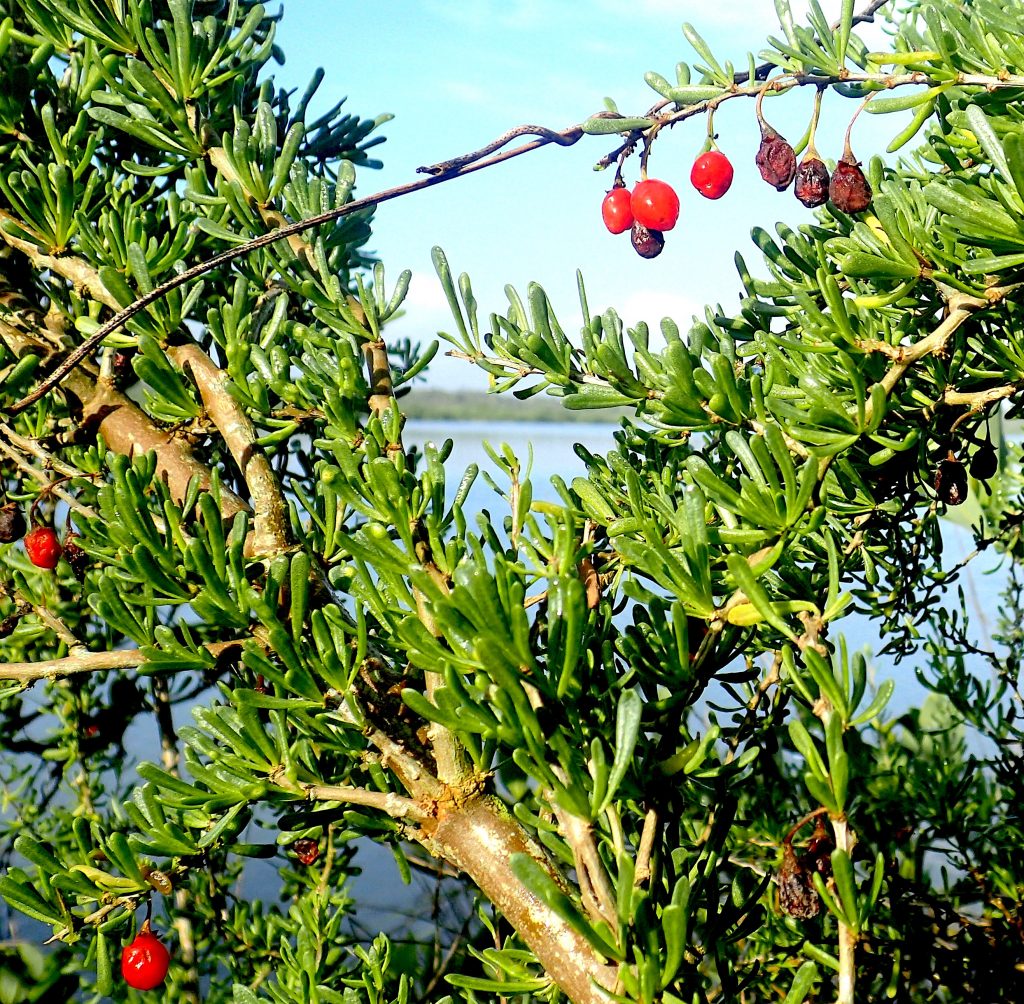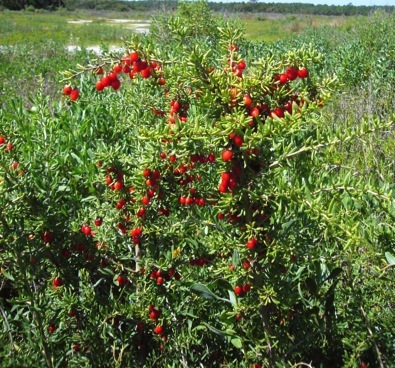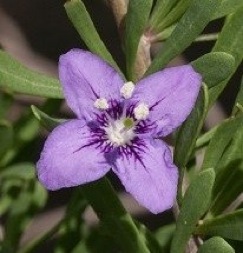
Photo by Green Deane
Christmas, Wolf, Goji, They’re All Berries
It’s called the Christmasberry even though it fruits from Christmas to April. And while it is one of several “Christmas Berries” this one happens to have a famous relative, the Goji berry of health food fame.
Botanically the Christmasberry is Lycium carolinianum (not to be confused with a couple of edible Crossopetalums also called Christmas Berry.) As for how Lycium carolinianum is pronounced is a bit of debate. Some say LIE-see-um, others lie-SEE-um. As the original word is from the Greek, λύκειον (LEE-kee-on) meaning a Greek school we might argue the genus is more properly LEE-see-um. Carolinianum means central North America and is said kar-row-linn-ee-AY-num.
For most of the year the Christmasberry is an unimpressive shrub that resembles from a distance a rosemary bush. But there are hints of more going on. Its leaves are plump and the shrub is salt tolerant, preferring coastal or inland areas of high saline content. In early winter or late spring the fruit is quite attractive and a welcomed food for woodland creatures particularly birds. Technically the L. carolinianum fruits all year in Florida but favors the late fall and to early spring. However, I have also found them in abundance in mid-spring and late fall.
While the foliage would not give it away as a member of the Solanaceae clan the blossoms and berries can. The blossoms look very similar to other Solanums and the berries have an ornamental pepper look, if not in color then shape. The seeds are a familiar look as well reminding one of small tomatoes or pepper seeds. Opinions on taste vary, from sweet and tomato-ish to famine food. All the ones I’ve eaten were on the sweet and juicy side, soft if not hollow but there is a bit of aromatic oil or flavor to them as well as well, nothing dramatic but definitely there.
While most foraging books ignore the L. carolinianum in their line up of edible Lyciums Dr. Fernando Chiang of the National University of Mexico confirms academically that the fruit is edible. Dr. Chiang is an expert on the genus and was consulted on the species for the publication of Florida Ethnobotany by Dr. Daniel Austin. Chiang describes the berries of other Lyciums as “often edible.” At least one, L. acnistoides, found in Cuba, is toxic. In some species the berries and the leaves (cooked) are eaten. With some edible, one toxic for certain, and others unreported it is best to identify carefully.
In North America among the edibles species, besides L. carolinianum, L. andeersonii, L. fremontii, L. pallidum, and L. torreyi. The leaves of the L. halimifolium are cooked and eaten in Eurasia as is the L. chinense. Best known, perhaps, is a Lycium closely related to the L. chinense, and that is the L. barbarum, also called the Goji (GO-gee) berry which oddly is naturalized in England. Also listed as edible is Lycium ferocissimum, which is a pest in Australia. Its native L. australe was eaten by the Aboriginals.
Also called the Wolfberry, L. barbarum is known as a powerful antioxidant and credited with giving you energy, in and out of bed, better metabolism, improved immune system response, blood pressure regulation, cardiovascular health and slowing down aging. Animal research suggest it may be effective against cancer, inflammatory diseases, macular degeneration and glaucoma. It is consumed in the form of pills, juice, dried fruit, powder, teas and the seeds eaten.
The Goji berry is about 68% carbs, 12% proteins, 10% each of fiber and fat. A 100-gram serving is about 370 calories. It has 11 essential dietary minerals and traces of 22 others; 18 amino acids, six essential vitamins, five unsaturated fats, and five carotenoids. Specifically it is high in calcium, potassium, iron, zinc, selenium, vitamin B2, Beta-carotene, and exceptionally high amounts of vitamin C. It’s also full of antioxidants via its pigment, which I would presume to be lycopene. If your local Lycium lives up to that, it would be quite a dietary addition.
Processed fruits of various species in the genus have also been used to treat diabetes, impotence, and to retard aging. One ingredient, Physalin, is extracted to treat Hepatitis B. Another chemical, Betaine, is taken by weightlifters to bulk up.
As a food Goji berrie (L. barbarum) are usually bought dried like raisins and are cooked before eaten. But the berries are also used to make a tea. Young Goji shoots and leaves are used as a cooked green. The one medical warning associated with Goji berries is they may increase the potency of drugs like Warfarin (making you bleed more easily.) Goji berries also contain atropine in low amounts.
Clearly you cannot assume your local Lycium is as all-around edible as the Goji is. But, identify and investigate. One would presume many of them would have similar nutritional profiles.
And one last thing: Goji berries are very high in lectins. If those bother you then perhaps you should try only a few at first or skip them altogether.
Green Deane’s “Itemized” Plant Profile
IDENTIFICATION:
Lycium carolinianum: Shrub to six feet, sprawling, spiny, small, succulent leaves. The four-petaled, somewhat tubular, lavender/blue flowers usually singular, red/orange berries, fleshy. Locally they are often covered with Ramalina, a hairy lichen.
TIME OF YEAR:
Fruits year around in Florida but favors mid-spring
ENVIRONMENT:
Salt tolerant, coastal areas or inland salty ground
METHOD OF PREPARATION:
Ripe berries, fresh or dried, as fruit or tea. I eat them off the bush.



